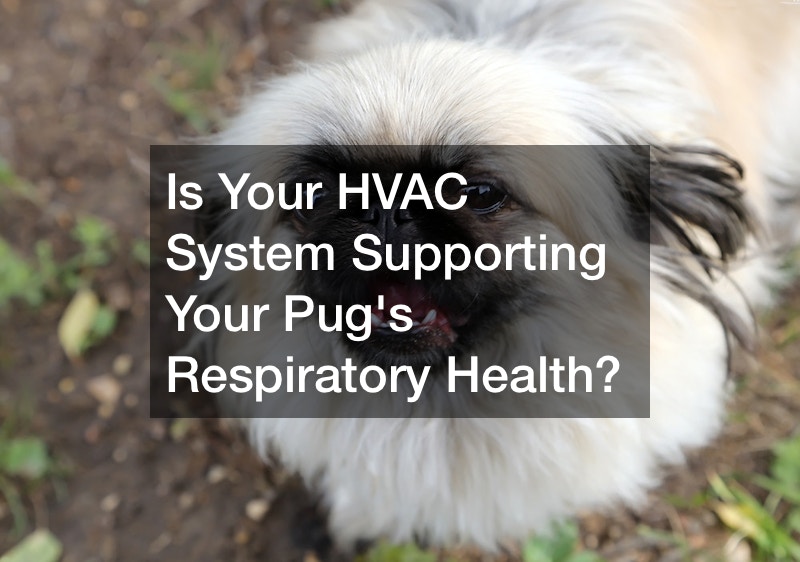

While pugs are notorious for snoring, flatulence, and drooling, they are still among the most popular dog breeds in the United States. And for a good reason: their compact size, clownish personality, and devotion to their owners make them the perfect companion for city living.
But many pug owners don’t realize there’s more to these dogs than meets the eye. They also have a unique respiratory system that puts them at risk for several health problems, including respiratory infections, allergies, and asthma.
Pugs and Their Unique Respiratory System
According to the American Kennel Club, pugs are brachycephalic dogs, meaning they have short snouts and flattened faces. This makes them prone to respiratory problems because their airways are narrower than average. In fact, pugs are so susceptible to respiratory problems that they’re banned from some airlines! That’s because the pressurized cabin can cause their airways to collapse, leading to severe distress.
Pugs have smaller nostrils and an elongated soft palate than other dog breeds. Because of this, they are more likely to snore and experience reverse sneezing (wheezing when inhaling). They are also more prone to heat stroke and exhaustion since they cannot pant as effectively to cool themselves down. It’s important to keep your pug cool in the summer months and ensure they have access to fresh, cool water at all times.
But don’t let all that worry you! With the proper care, these dog breeds can live long and healthy lives. One way to help your pug’s respiratory health is to ensure that you have a properly working HVAC system.

Role of HVAC Systems in Supporting Your Pug’s Respiratory Health
Many people don’t realize that their HVAC system can directly impact their respiratory health, especially those who suffer from allergies or asthma. But for pugs – an HVAC system can be a lifesaver. Here are a few ways in which an HVAC system can support your pug’s respiratory health:
1. Temperature Control
Temperature control is one way an HVAC system can support your pet’s respiratory health. That’s right – ensuring that your home’s temperature is comfortable for your pug can help keep its respiratory system healthy.
Pugs are especially susceptible to temperature changes. If it’s too cold, your pug may have trouble breathing. If it’s too hot, it may experience respiratory distress. This is where air conditioning systems come in. Your AC helps you to maintain a comfortable temperature in your home, so your pet can breathe easily.
2. Proper Humidity Levels
The respiratory system of a pug is very sensitive and can be easily irritated. This is why it’s important to maintain a comfortable humidity level in your home. An HVAC system can help you do this by automatically regulating the humidity level in your home.
This is important because too much humidity can lead to respiratory problems for your dog, while too little can dry out its respiratory system and make breathing difficult.
3. Good Indoor Air Quality
The air quality inside your home can greatly impact your pug’s respiratory health. Your HVAC system helps improve your home’s indoor air quality by circulating fresh, clean air and removing contaminants from the air.
The air in your home is constantly being cycled through your HVAC system, so it’s important to ensure that the air in your system is clean and free of allergens and other irritants. An air sampling test can help you identify any potential problems with the air in your HVAC system, so you can take measures to fix the problem and enhance the air quality within your home.
4. UV Germicidal Irradiation
The Environmental Protection Agency (EPA) states that UV germicidal irradiation is a great way to kill bacteria and viruses that could cause respiratory infections. This feature is often found in HVAC systems that use ultraviolet light to kill bacteria and viruses. This can be a great way to help your pet’s respiratory health by reducing its exposure to these harmful pathogens that can cause infections.
5. Reduced Stress
Keeping your pug comfortable and stress-free is important for their respiratory health. A good HVAC system can help to reduce your dog’s stress levels by creating a comfortable, inviting environment in your home. A calm, relaxed pug is less likely to have an asthma attack or other respiratory flare-ups.
Your HVAC system is essential to keeping your pug healthy. Remember to schedule a heating and air service for your HVAC system regularly to help ensure that your pug’s respiratory system stays healthy. Extra care can go a long way in ensuring your beloved pet has many years of good respiratory health.
The Risks of Poorly Functioning HVAC Systems on a Pug’s Respiratory Health
Many health risks are associated with poorly-functioning HVAC systems, especially for pugs. Since these dog breeds are especially susceptible to respiratory problems, ensuring your HVAC system works efficiently is important.
One of the biggest risks of a poorly functioning HVAC system is that it can lead to poor air quality. This can trigger several respiratory problems in pugs, including allergies, asthma, and even bronchitis. Another risk is that a poorly functioning HVAC system can cause pugs to overheat. As mentioned, they are already prone to heat stroke, which is a serious concern.
The EPA cautions that your HVAC system can become a breeding ground for mold and mildew if it is not properly cleaned and maintained. These can cause serious respiratory problems for your pug and can even be fatal.
If you suspect your HVAC system isn’t running properly, be sure to have it checked out by a professional. In the meantime, keep your pet well-ventilated and cool to avoid any problems.

How to Properly Maintain Your HVAC System to Ensure Your Pug’s Respiratory Health
Your dog’s respiratory health is important to you, and you want to make sure that your HVAC system is running properly to ensure their health. Here are some tips to properly maintain your HVAC system to ensure your pug’s respiratory health:
1. Change Your Air Filters Regularly
Dirty air filters can cause your pug to experience difficulty breathing. Imagine trying to breathe through a straw full of dirt and pollen – it wouldn’t be very easy, would it? The U.S. Department of Energy recommends you keep your air filters clean.
You can check them monthly and replace them as needed. When changing your air filters, follow the manufacturer’s instructions. Some air filters may need to be replaced more often than others, so it’s important to know what your specific filters require. You can easily find replacement air filters at your local HVAC supplies store.
2. Make Sure Your HVAC System’s Ductwork Is Clean
Ducts can accumulate dirt and dust over time, and if they’re not cleaned regularly, they can cause your HVAC system to blow dirty air into your home. This can be a problem for your pug, as they can end up breathing in all that dust and dirt, which is not good for their respiratory health. To avoid this, regularly clean your HVAC system’s ductwork. You can clean your ductwork yourself or hire a professional to do it for you.
3. Have Your HVAC System Professionally Serviced
Keeping your pet’s respiratory health in mind, ensuring that your HVAC system works efficiently is important. You can do this by having it professionally serviced at least once a year. This may include HVAC replacement or emergency air conditioner repairs. Having your HVAC system inspected and serviced by a professional will help ensure that it is functioning properly and can help prevent any potential problems.
4. Keep Your Home Clean
Keeping your home clean is important to maintaining your HVAC system and ensuring your pet’s respiratory health. Dust and dirt can accumulate in your home and, if not cleaned regularly, can be blown into your HVAC system and re-circulated through your home. This can cause problems with your pug’s respiratory system, so it is important to clean your home regularly.
You can do this yourself or hire a home cleaning service to do it for you. Either way, keeping your home clean is an important part of keeping your pug’s respiratory system healthy.
Following these HVAC maintenance tips can help support your pug’s respiratory health and avoid potential problems down the road.

Choosing the Right HVAC System for Your Pug’s Respiratory Health
One of the best things you can do to help your furry friend stay healthy is to choose the right HVAC system for your home. Here are five tips to help you choose the best HVAC system for your pug’s respiratory health:
1. Get an Air Quality Test
The first step in choosing the right HVAC system for your pug’s respiratory health is to get an air quality test done in your home. This will help you identify problem areas in your home’s air quality. Once you know what areas need improvement, you can choose an HVAC system that will address those specific needs.
2. Choose an HVAC System With a High MERV Rating
When choosing an HVAC system, opting for one with a high MERV rating is key. MERV stands for Minimum Efficiency Reporting Value. The higher the MERV rating, the better the HVAC system is at trapping airborne contaminants that could trigger your dog’s respiratory problems.
3. Select the Right Size HVAC System
When choosing an HVAC system, selecting a system that’s the right size for your home is important. If the system is too small, it won’t be able to heat or cool your home effectively. This can be a problem for pugs due to their respiratory problems. You can consult a professional to help choose the right HVAC system size for your needs.
4. Consider Your Pug’s Unique Needs
For instance, if your pug has allergies, you’ll want to choose an HVAC system with a high-efficiency particulate air (HEPA) filter. HEPA filters are even more effective at trapping airborne contaminants than HVAC systems with a high MERV rating.
According to the EPA, HEPA filters are designed to capture 99.97% of all airborne particles that are 0.3 microns or smaller. This makes them ideal for protecting your pug from harmful pollutants, dust, and other allergens that can trigger respiratory problems.
5. Ask Your Vet for Recommendations
If you’re unsure which HVAC system is right for your pet’s respiratory health, your vet may be able to provide some guidance. Vets are familiar with the respiratory needs of different animals, so they can offer helpful insights you may not have considered.
For example, your vet may recommend an HVAC system with a higher MERV rating or one that uses HEPA filters. Following your vet’s advice can help ensure your pug stays healthy and free of respiratory infections.
These tips will help you choose the right HVAC system for your pug’s respiratory health. Taking the time to research and make an informed decision will help ensure that your loyal pet enjoys many happy and healthy years to come.

Helpful Tips on How to Maintain a Pug’s Respiratory Health
In addition to having a good HVAC system, here are a few tips to help you keep your pet’s respiratory system healthy and functioning properly:
- Keep your pug cool and comfortable.
- Make sure your pug has access to clean water.
- Give your pug regular baths to help remove irritants from its coat.
- Keep your pug’s sleeping area clean and dust-free.
- Avoid smoking indoors.
- Make sure your pug is up-to-date on all vaccinations.
- Take your pet to the vet for regular checkups.
Following these tips can help keep your dog’s respiratory system healthy and functioning properly. Remember, if you have concerns about your pug’s respiratory health, talk to your vet.
Bottom Line
Our pets are a part of our families, and we want them to be healthy and happy. Since pugs are especially susceptible to respiratory problems, ensuring their home environment is as healthy as possible is important. And one of the best ways to do that is to ensure your HVAC system supports their needs.
If your HVAC system is not supporting your pug’s respiratory health, you may want to consider making some changes. By ensuring that your pug has access to clean air and a comfortable environment, you can help to keep your beloved pet’s respiratory system healthy and functioning properly.
Share This :
